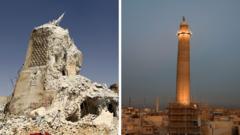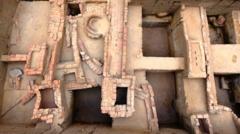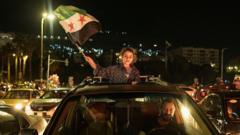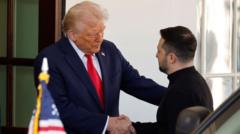In a significant step towards recovery, historic landmarks in Mosul, Iraq, including churches and mosques, are set to reopen to the public, signaling the city’s resurgence after years of destruction caused by the extremist Islamic State (IS) group. This comprehensive restoration project was initiated by UNESCO, which commenced one year after IS was ousted from Mosul in 2017.
The project’s unveiling will be attended by UNESCO's Director-General, Audrey Azoulay, alongside local artisans, residents, and leaders from various religious communities. Mosul, once a beacon of tolerance before its fall to IS in 2014, endured profound suffering under the group's rule, with rampant violence targeted at minorities and opponents.
Photographer Ali al-Baroodi recalls returning to Mosul after its liberation, confronting a nightmarish scene where the iconic al-Hadba minaret, symbolic of the city for centuries, lay in ruins. He described the devastation felt like a "ghost town," epitomizing the drastic changes visited upon a place once filled with life and culture.
Over 80% of Mosul's Old City was severely damaged during IS's occupation, and rebuilding efforts encompassed not only the city’s physical structures but also the fabric of its community, which had historically thrived in harmony among diverse groups. The monumental undertaking was funded by $115 million, primarily sourced from the United Arab Emirates and the European Union.
Father Olivier Poquillon, a Dominican priest overseeing the restoration of the al-Saa'a convent, emphasizes that the challenge wasn't merely structural repair, but rebuilding trust among the different communities to ensure a shared future. "If you want to rebuild the buildings, you've got to rebuild trust first,” he stated, showcasing how collective efforts among Christians and Muslims played an essential role throughout the reconstruction process.
Led by chief architect Maria Rita Acetoso, the extensive project has led to the restoration of 124 historic houses and has proven beneficial in job creation, cultivating skills among over 1,300 local youths, with women constituting 30% of the engineering workforce. The effort also included the renovation of classrooms and the recovery of thousands of historical artifacts.
After years of silence, the sounds of church bells can once again be heard ringing out across Mosul, with landmarks such as the Dominican al-Saa'a Convent and the intricate Al-Tahera Church restored to their former glory. Longtime residents, like Mustafa and Abdullah, express joy and relief at returning to homes that were once thought irreparable.
While signs of recovery are evident, many scars from the past remain, a reminder of the fragility of peace in Iraq. Yet, the revitalization witnessed in the Old City harbors the promise of a brighter future. As al-Baroodi eloquently puts it, witnessing the rebirth of his city is like "seeing a dead person coming back to life," capturing the essence of Mosul’s recovery and its enduring spirit.
The project’s unveiling will be attended by UNESCO's Director-General, Audrey Azoulay, alongside local artisans, residents, and leaders from various religious communities. Mosul, once a beacon of tolerance before its fall to IS in 2014, endured profound suffering under the group's rule, with rampant violence targeted at minorities and opponents.
Photographer Ali al-Baroodi recalls returning to Mosul after its liberation, confronting a nightmarish scene where the iconic al-Hadba minaret, symbolic of the city for centuries, lay in ruins. He described the devastation felt like a "ghost town," epitomizing the drastic changes visited upon a place once filled with life and culture.
Over 80% of Mosul's Old City was severely damaged during IS's occupation, and rebuilding efforts encompassed not only the city’s physical structures but also the fabric of its community, which had historically thrived in harmony among diverse groups. The monumental undertaking was funded by $115 million, primarily sourced from the United Arab Emirates and the European Union.
Father Olivier Poquillon, a Dominican priest overseeing the restoration of the al-Saa'a convent, emphasizes that the challenge wasn't merely structural repair, but rebuilding trust among the different communities to ensure a shared future. "If you want to rebuild the buildings, you've got to rebuild trust first,” he stated, showcasing how collective efforts among Christians and Muslims played an essential role throughout the reconstruction process.
Led by chief architect Maria Rita Acetoso, the extensive project has led to the restoration of 124 historic houses and has proven beneficial in job creation, cultivating skills among over 1,300 local youths, with women constituting 30% of the engineering workforce. The effort also included the renovation of classrooms and the recovery of thousands of historical artifacts.
After years of silence, the sounds of church bells can once again be heard ringing out across Mosul, with landmarks such as the Dominican al-Saa'a Convent and the intricate Al-Tahera Church restored to their former glory. Longtime residents, like Mustafa and Abdullah, express joy and relief at returning to homes that were once thought irreparable.
While signs of recovery are evident, many scars from the past remain, a reminder of the fragility of peace in Iraq. Yet, the revitalization witnessed in the Old City harbors the promise of a brighter future. As al-Baroodi eloquently puts it, witnessing the rebirth of his city is like "seeing a dead person coming back to life," capturing the essence of Mosul’s recovery and its enduring spirit.





















